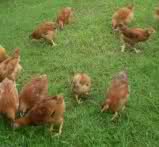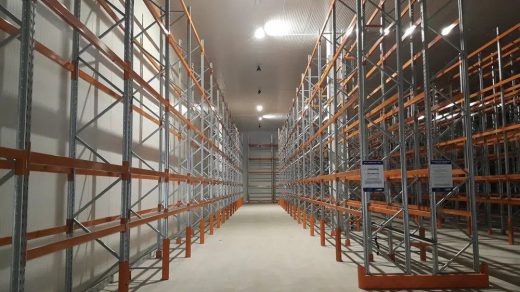 Sunshine chickens are Solraya’s brand of imported chicken from France. This free ranged, grass fed, naturally grown, pastured colored chickens are becoming the favorite of most chicken raisers. Raisers of sunshine chicken praised the plump body of the bird, its fast growth, its sturdiness and its taste that resembles that of the native chicken. And because they are raised on pasture, real free-range sunshine chickens are nutritionally superior.
Sunshine chickens are Solraya’s brand of imported chicken from France. This free ranged, grass fed, naturally grown, pastured colored chickens are becoming the favorite of most chicken raisers. Raisers of sunshine chicken praised the plump body of the bird, its fast growth, its sturdiness and its taste that resembles that of the native chicken. And because they are raised on pasture, real free-range sunshine chickens are nutritionally superior.
In 2007, Mother Earth News did an egg study comparing free-range eggs to the U.S. Department of Agriculture (USDA) nutrient data for commercial eggs. The findings showed that free-range chicken eggs produced the following results:
• 1/3 less cholesterol
• 1/4 less saturated fat
• 2/3 more vitamin A
• 2 times more omega-3 fatty acids
• 3 times more vitamin E
• 7 times more beta-carotene
• 4 to 6 times as much vitamin D (latest result)
The most likely cause of the differences between free-range eggs and those from caged, commercial-production hens is the diet the chickens consume every day and the exposure they get in direct sunlight, which their bodies convert to vitamin D and then pass on to the eggs. That’s the wonder of sunshine chickens!
Solraya, the only importer of Certified Parent Stocks sunshine chickens, is now producing the sunshine chicks using parent stocks imported from the SASSO company in France to make it economically viable to raise and to ensure a stable supply of quality chicks for meat or egg production.
Here is a guide in Raising Sunshine Chickens from solraya blogspot.
Caring of Sunshine Chicks (first 21days)
NOTE: It is imperative to keep surroundings and chicken houses disinfected and clean.
Housing of Birds: Secure from predators, i.e., rats, cats, and dogs. Fencing wire may be buried below the surface to prevent any of predators from getting to the birds. You need light, heat, and water. As for temperature, birds (four weeks of age or older) are best suited for 70oF. Important to have shaded areas. Location should be well drained. Lay rice hull or wood shavings for absorbent flooring. Good choice for bedding materials during the wet season is sand, because it allows for excellent drainage.
Brooding the Birds: By practice, use one (1) watt per bird for heating bulbs. It is better to use several bulbs in smaller wattages (ten 10w bulbs, four 25w bulbs), rather than using a 100watt bulb when you brood 100 chicks. Temperature should be 70 to 75oF with the temperature at chicks’ level to be 95oF during the first week. The area assigned to these chicks should have some flexibility such that they can move through a range of temperatures (95 to 75oF). Monitor the birds for signs of stress; for instance, if the chicks are scattered around the area and chirping loudly, chances are they are hot; conversely, if you notice the chicks all huddled together in one area, they are likely cold . They should be comfortably scattered, moving around. That is your basis that temperature is right. The temperatures given are just guides. Use your eyes to monitor them. At the end of Week 1, begin dropping the temperature by 5oF per week until you reach 70oF, and then try to maintain that temperature.
Water and Feed: The most neglected and overlooked nutrient is water. What appears to be a bowl of “clean water;” may contain millions of bacteria. The bacteria will stress the digestive system of the bird, such that it will not grow at the rate believed to be their potential. The waterers and feeders should be cleaned routinely daily. Leave under the sun to disinfect. Best to have two or three sets of equipments so you can disinfect/clean properly. Fresh water needs to be supplied everyday to insure healthy birds. During the periods of extreme heat, there is an increased risk of microbial growth.
We suggest using probiotics/vitamins in their drinking water, and adlibitum feeding of chick booster for the 1st 21days, prior to ranging. Make sure feeding trays are NEVER EMPTY. Medicate only when necessary.
Vaccinations: Day 7 – B1 B1; Day 14 – B1 La Sota
Ranging, Day21 onwards, till slaughter: Segregate by net, compartments for ranging area around their pen. That way, you are able to rotate ranging areas. When you rotate, the manure fertilizes the land and you move to another ranging area so as not to deplete a small section. You may also want to use movable pens, so they have fresh grass everyday and litter will not be a problem.
Let them range freely in open air, eating grass, insects, table scraps, or what is abundant in your area. Feed adlibitum even when they are already on the range. Have feeds in feeders, so they will be able to eat at will. Give probiotics/vitamins everyday in drinking water (optional).
You may get the marketable weight at 49-63days. For best tasting chickens, slaughter at 85-90 days. RAISED FOR MEAT & EGG PRODUCTION, NOT FOR BREEDING- solraya
Where to buy day old chicks?
visit: Sunshine chickens dealer list
If you want to build a small chicken coop for your sunshine chickens, visit: How to Make a Small Chicken Coop guide.
For additional guide in constructing sunshine chicken houses, feeding and maintenance techniques, visit: Raising Free- Range Chickens
To know more of this Sunshine chickens, visit Solraya’s website at http://solraya.blogspot.com. They also conduct free seminars.
Do you like this Money Making Business Idea? then please consider subscribing to our RSS feed. You can also subscribe by email and have new articles sent directly to your inbox. (Once you entered your e-mail address, you need to login to your e-mail account and click the link to confirm your subscription).



san po pwede makabili ng sunshine chicken…
I am interested to livestock business , do you cater within mindanao particularly davao city? do you conduct seminars in this particular area?